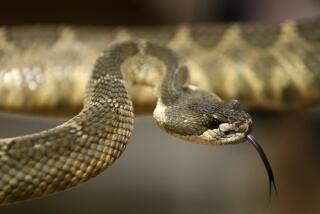Man Finds Viper Attack Is Painful and Costly : Safety: A bicyclist learns the hard way that coiled reptiles on mountain trails should be left alone.
- Share via
Dave Heinrichs has learned his lesson, and it nearly cost him a finger.
Bicycling through the Santa Monica Mountains on a sunny May afternoon, the 26-year-old Newbury Park man spotted a baby rattlesnake lying coiled in the middle of the trail. Rushing in where others might fear to tread, he dismounted his bike and stooped to investigate.
Picking up the snake was easy, with a quick grab behind the snake’s head--a skill cultivated during a boyhood spent playing with reptiles of various shapes and sizes. It was when Heinrichs erred on the side of leniency that he found himself on the wrong end of a fang.
“I thought I was squeezing too hard, and I didn’t want to hurt it,” he said. “I loosened my grip--and then it managed to squirm just a little and nick my left index finger. . . .
“I didn’t know how long I had.”
His brother went for help. Heinrichs sucked his wound and spit out the blood, attempting a folk remedy that doctors say can easily do more harm than good.
Ambulance sirens screamed out his arrival at Los Robles Regional Medical Center in Thousand Oaks, where swelling from the bite soon began in earnest--first in his hand, then up his arm, finally to his shoulder.
“Every hour, the nurse would come in and measure the arm, and put an ink mark on the progression,” Heinrichs said. “And it just kept on going.”
The next morning Heinrichs thought his ballooning hand would split open at the seams. “That was the most pain I had,” he said. Physicians administered 22 vials of antivenin--a large amount according to Dr. Bob Galli, snakebite consultant for the Los Angeles County Medical Assn.’s Regional Poison Control Center.
The ordeal lasted six days. Three of those Heinrichs spent in intensive care.
The other three were spent in hyperbaric treatment to counteract the gangrene spreading up Heinrichs’ finger, the specter of amputation looming uncomfortably large. During the treatment, Heinrichs breathed pure oxygen from a machine normally used for deep-sea divers suffering the bends.
Luckily, it worked, saving not only the finger but Heinrichs’ livelihood--designing and building custom furniture. Only the nerve endings in the tip of the finger suffered damage.
And a rueful Heinrichs said he left the hospital several weeks ago with a clear understanding that a snake in the hand isn’t worth $20,000 in medical bills--and excruciating pain.
“You know, I’ve seen three snakes since this has happened, but I won’t pick up any more,” he declared, his recent experience sounding a note of resolve in his voice. “I’ve learned my lesson.”
Hikers can take a number of steps to prevent an encounter with rattlers and other venomous snakes:
* Wear protective clothing, such as heavy shoes and socks, at least from the calf down. Pants are preferable to shorts.
* If climbing, wear protective gloves.
* Hike with a walking stick that you can poke into areas where you cannot see. For example, if you are about to step over a log, the walking stick should go first.
* Know the location of the nearest health-care facility.
Do’s and Don’ts With Snakebites
* DON’T cut the wound and attempt to suck out venom-tainted blood. The cuts will make the wound more difficult to heal, and the venom spreads too quickly for much to be extracted. Venom may also enter the bloodstream through cuts and cavities in the mouth, and can render breathing difficult.
* DON’T apply a tourniquet too tightly, if using one at all. There is no good evidence that tourniquets slow the spread of venom, and a tourniquet applied too tightly will endanger all the tissue beneath the point of application.
* DON’T apply ice to the bite. This reduces the blood supply, hastens the venom’s spread and causes the venom to work more aggressively, increasing tissue damage.
* DON’T try to kill the rattlesnake and bring it along to the hospital. This often leads to multiple bites. Emergency physicians do not need to know the type of rattlesnake to administer antivenin.
* DO stay calm and get away from the snake.
* DO immobilize the extremity bitten, if possible--for example, by putting an arm in a sling.
* DO get to a health-care facility as quickly as possible.
SOURCE: Los Angeles County Medical Assn.’s Regional Poison Control Center
More to Read
Sign up for Essential California
The most important California stories and recommendations in your inbox every morning.
You may occasionally receive promotional content from the Los Angeles Times.











